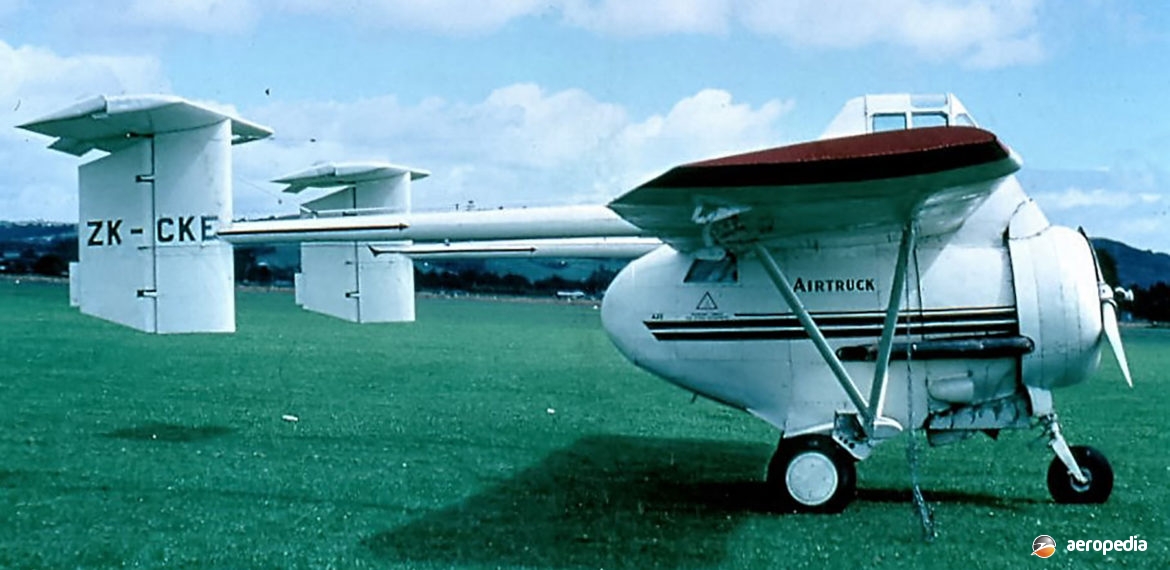Photograph:
Bennett Aviation Airtruck ZK-CKE (c/n 002) at Palmerston North, NZ (Ben Dannecker)
Country of origin:
New Zealand
Description:
Single-engine agricultural aircraft
Power Plant:
One 410 kw (550 hp) Pratt & Whitney R-1340 Wasp nine-cylinder air-cooled radial engine
Specifications:
- Wingspan: 14.63 m (48 ft)
- Length: 7.82 m (25 ft 8 in)
- Height: 3.3 m (10 ft 10 in)
- Wing area: 34.28 m² (369 sq ft)
- Area of stub wing: 2.42 m² (26 sq ft)
- Max speed at sea level: 264 km/h (164 mph)
- Economical cruising speed: 200 km/h (124 mph)
- Range with max fuel: 724 km (450 miles)
- Empty weight: 1,678 kg (3,700 lb)
- Loaded weight: 3,266 kg (7,200 lb)
History:
The Bennett Aviation Airtruck was designed by Luigi Pellarini and built by Bennett Aviation Limited at Te Kuiti on the north island of New Zealand. Basically it was a development of the Kingsford Smith PL-7 Tanker and used some of the ideas from that design but using parts from ex-RNZAF Harvards which were available cheaply and in numbers.
Like the two earlier agricultural designs by Mr Pellarini, the Airtruck had individual tail units, thus permitting faster loading of the hopper aft of the cockpit. The design was aimed at the crop-spraying and dusting market and used as many Harvard components as possible. The pod-type fuselage contained a fertiliser hopper with a capacity of 1,905 kg (4,200 lb) but it was expected the machine would be licensed to carry 1,016 kg (2,240 lb), and this would be increased later to 1,524 kg (3,360 lb).
Initially the design was expected to be fitted with an Armstrong Siddeley Cheetah engine of 336 kw (450 hp) but when George Bennett of Bennett Aviation, John Worthington and businessman Jack Gardner, partners in the Company, became aware that a number of surplus ex-RNZAF North American Harvards were available, Pellarini re-designed what had been the PL-9 with the Cheetah engine around the Pratt & Whitney R-1340 which was available, the Pratt & Whitney engine providing a lot more power and being available in some numbers at a reasonable cost.
The design was of all-metal structure, a high-wing monoplane with steel sub wings, V-lift struts and a steerable tricycle undercarriage. The pilot’s seat was mounted over the engine to provide good forward vision, the canopy being a modified Harvard unit. The twin-boom fuselage was designed around the idea of preventing corrosion from superphosphate in the rear fuselage, and allowed easier filling of the hopper.
The prototype ZK-BPV (c/n BA-001), which incorporated the power plant of one of two North American Harvard IIs (NZ913 or NZ931), used other components such as parts of the cockpit canopy, hydraulics, etc, and made its initial flight on 28 April 1960, comprising a short hop, at Te Kuiti. Fast taxi trials had been carried out on 14 April. It was initially registered to Bennett Aviation but the Company was restructured as Waitomo Aircraft Ltd. First official test flight was made on 2 August 1960.
Trials for a Certificate of Airworthiness were completed but it was not issued at that stage by the Civil Aviation Department as full stress calculations were not available. More than 100 hours were flown on the prototype. Work proceeded on a second Airtruck, and commenced on a third machine. In this regard, Bennett Aviation purchased a bulk lot of 60 surplus North American Harvards from the RNZAF in March 1959 and had them transported by rail to Te Kuiti with a view to using as much of each Harvard as possible in the construction of the PL-11 Airtrucks.
The prototype entered service with Northern Aviation for trial purposes but was lost at Ngapenga on 8 October 1963 when it struck a steep hillside and crashed into a swamp shortly after take-off. The aircraft was removed from the register on 21 October, having completed about 110 flying hours.
The second machine was completed ZK-CKE (c/n 002), the Company stating it had interest in the design from operators and proposed to build an initial batch of ten aircraft. This machine, VH-CKE, made its first flight on 9 March 1965, five years after the loss of the prototype. This eventually received a full Certificate of Airworthiness and initial service was with Northern Air Services for trials. It then saw service with Rural Aviation for a period.
Consideration was then given to moving production to the Bell Block airfield at New Plymouth, a larger facility, and efforts were made to raise finance. The Company stated it would be able to produce an aircraft every two months. The second aircraft ZK-CKE was registered to Rural Aviation and leased by Northern Air Services, some trials being carried out in 1966 on the west coast of the south island of New Zealand.
At one stage ZK-CKE was used for rabbit baiting contracts from Te Anau and Hokitika. In October 1966 Commercial Aircraft (NZ) Ltd was formed to manufacture the PL-11, stating five would be completed in 1967, orders for 17 having been received, including a number for Uruguay to be financed by the World Bank. By February 1967 the second aircraft was operated by Barr Brothers Ltd of Auckland and was operated from Dargaville. ZK-CKE was lost in an accident on 1 March 1967 whilst taking off at Tangiwha, Maungakaramea.
Only the two machines mentioned were completed. Luigi Pellarini went on to design the PL-12, built by Transavia in Sydney, NSW and other designs, including the Victa R-2.

